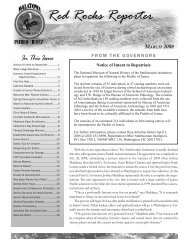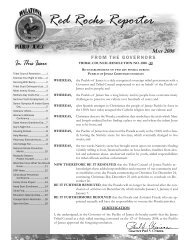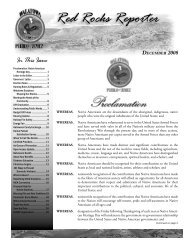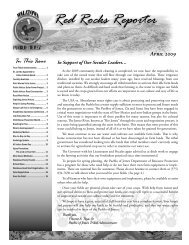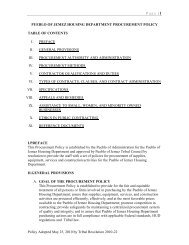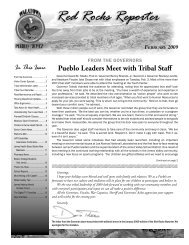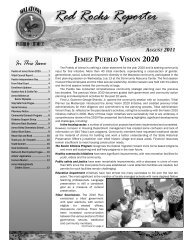Create successful ePaper yourself
Turn your PDF publications into a flip-book with our unique Google optimized e-Paper software.
Page 12 <strong>March</strong> <strong>2012</strong> <strong>Pueblo</strong> <strong>of</strong> <strong>Jemez</strong> Red Rocks Reporter<br />
PUBLIC HEALTH<br />
GET YOUR PLATE IN SHAPE<br />
<strong>March</strong> is National Nutrition Month<br />
Celebrate National Nutrition Month’s theme <strong>of</strong> “Get Your Plate in Shape” by giving<br />
your eating plan a healthy Spring makeover.<br />
“Vegetables, fruits, whole grains, lean<br />
proteins and low-fat dairy products contain<br />
the nutrients we need to maintain healthy<br />
lifestyles,” says Diabetes Educator Gail<br />
M Overton, MS, LN, LD. “Make sure your<br />
eating plan includes foods from all the food<br />
groups. And pay attention to portion control<br />
for your healthy eating plan.”<br />
Tips to “Get Your Plate in Shape”<br />
Make half your plate fruits and<br />
vegetables.<br />
Eat a variety <strong>of</strong> vegetables, especially<br />
dark-green, red and orange varieties,<br />
as well as beans and peas.<br />
When buying canned vegetables,<br />
choose “reduced sodium” or “no salt<br />
added.” Rinse beans, corn and peas to<br />
reduce salt levels.<br />
Choose dried and frozen fruits and<br />
those canned in water or their own juice<br />
when fresh fruits are not available.<br />
Make sure every meal and snack has at<br />
least one fruit or vegetable or both.<br />
Make at least half your grains whole.<br />
Choose brown rice, barley, oats and<br />
other whole grains for side dishes.<br />
Switch to 100 percent whole-grain<br />
breads, cereals and crackers.<br />
Check the ingredients list on food<br />
packages to fi nd foods that are made<br />
with whole grains.<br />
Switch to fat-free or low-fat milk.<br />
Fat-free and low-fat milk have the same<br />
amount <strong>of</strong> calcium and other essential<br />
nutrients as whole milk, but less fat<br />
and fewer calories.<br />
If you can't drink milk, try lactose-free<br />
milk or calcium-fortifi ed soy milk.<br />
Vary your protein choices.<br />
Eat a variety <strong>of</strong> foods from the protein<br />
food group: seafood, nuts and beans,<br />
lean meat, poultry and eggs.<br />
Eat more plant-based proteins such as<br />
nuts, beans, whole grains and whole<br />
soy foods like t<strong>of</strong>u and edamame.<br />
At least twice a week, make fi sh or<br />
seafood the protein on your plate.<br />
Keep meat and poultry portions lean<br />
and limit to three ounces per meal.<br />
Cut back on salt and empty calories<br />
from solid fats and added sugars.<br />
Drink water instead <strong>of</strong> sugary drinks<br />
like regular sodas, fruit-fl avored drinks<br />
and sweetened teas and c<strong>of</strong>fees.<br />
Choose 100-percent fruit juice.<br />
Compare sodium in foods and choose<br />
those with the lowest amount listed on<br />
the Nutrition Facts Panel.<br />
Season foods with spices or herbs<br />
instead <strong>of</strong> salt.<br />
Choose lean cuts <strong>of</strong> meat or poultry<br />
and fat-free or low-fat dairy products.<br />
Use heart-healthy oils like olive, canola<br />
and sunfl ower oil in place <strong>of</strong> butter or<br />
shortening when cooking.<br />
“When you cook at home, you control<br />
what's in your food,” Gail adds. “Exercise<br />
along with healthful eating are crucial to<br />
maintaining a healthy lifestyle.”<br />
Obesity and Diabetes in <strong>Jemez</strong><br />
Continued from page 8<br />
Obesity in <strong>Jemez</strong> <strong>Pueblo</strong><br />
JHHS Public Health Programs statistics<br />
show that nearly half <strong>of</strong> our tribal members<br />
are either overweight or obese. Our families,<br />
neighbors and friends are at great risk for<br />
developing type 2 diabetes and the terrible<br />
complications the disease brings, including<br />
blindness, kidney disease that requires<br />
dialysis, amputations, heart attack and stroke.<br />
“Preventing diabetes, preventing obesity,<br />
preventing cancer, preventing heart disease<br />
has everything to do with maintaining and<br />
strengthening our traditions and culture,”<br />
says Kristyn Yepa, Public Health Program<br />
Manager. “We need to start supporting our<br />
local farmers and eating foods that are fresh,<br />
running or walking, and focusing on changing<br />
our eating habits.”



